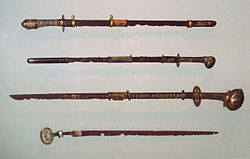Chokutō
This article needs additional citations for verification. (January 2012) |

The chokutō (直刀, "straight sword") is a straight uncurved Japanese sword that was produced prior to the 10th century.[1]Chokutō were used on foot for stabbing or slashing and were worn hung from the waist.[2]
History
Chokutō was among the earliest in the history of Japanese swordforging. It was created before development of differential tempering in Japanese swordsmithing. Chokutō typically come in hira-zukuri and kiriha-zukuri tsukurikomi (blade styles) which make them very distinct from later tachi and katana which rarely use these forms. The distinctive feature of the chokutō is the straight blade, similar to the ancient swords found in the Three Kingdoms Period of China. Its blades are also often confused with those of shikomizue; there is little evidence to suggest that Chokutō were ever mounted as cane swords.
Though curved blades are as old as the sword itself, they did not become widespread in Asia and the Middle East until after the dominance of the Mongol Empire. Japanese warriors of the Kamakura Shogunate experienced the effectiveness and lethality of curved blades firsthand in the Mongol invasions of Japan. Rudimentary forms what would eventually become the tachi gradually began to eclipse the chokutō in popularity as the curved blades demonstrated greater ease of handling and lethality in mounted combat.
Decline
Kofun period chokutō like other period swords relied on the weight of the blade in executing slashing rather than thrusting attacks. The advent of the Japanese katana design with its curved single-edged blade and superior metallurgy allowed for the development of specialised swordfighting techniques such as Iaidō.
Very few examples of chokutō mountings remain, although enough to reconstruct their various typologies which always followed Chinese and Korean models; this is evident in one of the last Kofun period sword types developed, the single-edged warabitetō (蕨手刀).
Gallery
-
Tsurugi or ken, a double-edged straight sword, Kofun period, 5th century, Met Museum.
-
Hilts of Japanese straight swords, Kofun period, 6-7th century, Met Museum.
-
Two Chinese swords (top) of the Sui Dynasty. Bottom: Japanese sword with scabbard, Kofun period, 6th century, Met Museum.
-
Sword hilts, end of the Kofun period, Japan, 6th century. Musee Guimet.



